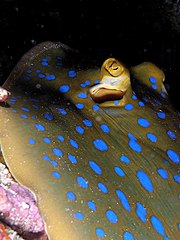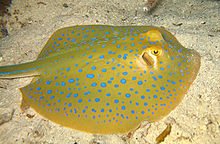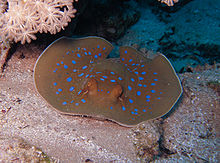Bluespotted ribbontail ray
| Bluespotted ribbontail ray | |
|---|---|

| |
| Scientific classification | |
| Domain: | Eukaryota |
| Kingdom: | Animalia |
| Phylum: | Chordata |
| Class: | Chondrichthyes |
| Subclass: | Elasmobranchii |
| Superorder: | Batoidea |
| Order: | Myliobatiformes |
| Family: | Dasyatidae |
| Genus: | Taeniura |
| Species: | T. lymma
|
| Binomial name | |
| Taeniura lymma (Forsskål, 1775)
| |

| |
| Range of the bluespotted ribbontail ray | |
| Synonyms | |
| |
The bluespotted ribbontail ray (Taeniura lymma) is a
At night, small groups of bluespotted ribbontail rays follow the rising tide onto sandy flats to root for small benthic
Taxonomy and phylogeny

The bluespotted ribbontail ray was originally described as Raja lymma by
Other
Distribution and habitat
Widespread in the
Description

The
The skin is generally smooth, save for perhaps a scattering of small thorns on the middle of the back.[9] The dorsal coloration is striking, consisting of numerous circular, neon blue spots on a yellowish brown or green background; the spots vary in size, becoming smaller and denser towards the disc margin. The tail has two stripes of the same blue running along each side as far as the spines. The eyes are bright yellow and the belly is white.[3][8] Individuals found off southern Africa may lack the blue tail stripes.[10] The bluespotted ribbontail ray grows to 35 cm (14 in) across, 80 cm (31 in) long, and 5 kg (11 lb).[5][11]
Biology and ecology

One of the most abundant stingrays inhabiting Indo-Pacific reefs, the bluespotted ribbontail ray generally spends the day hidden alone inside caves or under coral ledges or other debris (including from
Breeding in the bluespotted ribbontail ray occurs from late spring to summer; the male follows the female and nips at her disc, eventually biting and holding onto her for
Known predators of the bluespotted ribbontail ray include
Human interactions
While timid and innocuous towards humans, the bluespotted ribbontail ray is capable of inflicting an excruciating wound with its
The
References
- ^ doi:10.2305/IUCN.UK.2021-1.RLTS.T116850766A116851089.en. Retrieved 19 November 2021.)
{{cite journal}}: CS1 maint: multiple names: authors list (link - ^ a b Eschmeyer, W.N. and R. Fricke, eds. lymma, Raja Archived 2012-02-21 at the Wayback Machine. Catalog of Fishes electronic version (January 15, 2010). Retrieved on February 17, 2010.
- ^ ISBN 978-1-86825-394-4.
- ^ Eschmeyer, W.N. and R. Fricke, eds. Taeniura Archived 2012-02-21 at the Wayback Machine. Catalog of Fishes electronic version (January 15, 2010). Retrieved on February 17, 2010.
- ^ a b c d Froese, Rainer; Pauly, Daniel (eds.) (2009). "Taeniura lymma" in FishBase. November 2009 version.
- .
- ^ ISBN 978-0-8248-1808-1.
- ^ ISBN 978-1-55209-629-1.
- ^ ISBN 978-92-5-104302-8.
- ^ ISBN 978-1-920033-01-9.
- ISBN 978-1-77007-345-6.
- ^ ISBN 978-0-930118-18-1.
- ^ a b c d Bester, C. Biological Profiles: Bluespotted Ribbontail Ray Archived 2016-01-04 at the Wayback Machine. Florida Museum of Natural History Ichthyology Department. Retrieved on November 13, 2009.
- ^ a b Miller, J. (2002). Taeniura lymma (On-line). Animal Diversity Web. Retrieved on November 13, 2009.
- ^ ISBN 978-0-674-03411-2.
- ISBN 978-0-521-81597-0.
- S2CID 28791035.
- S2CID 43767236.
- ^ Ramadan, M.M. (1986). "Cestodes of the genus Cephalobothrium Shipley and Hornel, 1906 (Lecanicephaliidae), with description of C. ghardagense n. sp. and C. taeniurai n. sp. from the Red Sea fishes". Japanese Journal of Parasitology. 35 (1): 11–15.
- ^ Tyler, G.A. (II) (2006). "Tapeworms of elasmobranchs (part II) a monograph on the Diphyllidea (Platyhelminthes, Cestoda)". Bulletin of the University of Nebraska State Museum. 20: i–viii, 1–142.
- PMID 7086222.
- ^ Palm, H.W. & I. Beveridge (May 2002). "Tentaculariid cestodes of the order Trypanorhyncha (Platyhelminthes) from the Australian region". Records of the South Australian Museum. 35 (1): 49–78.
- PMID 7153551.
- PMID 6736718.
- .
- ^ Chisholm, L.A. & I.D. Whittington (1999). "Empruthotrema quindecima sp. n. (Monogenea: Monocotylidae) from the nasal fossae of Taeniura lymma (Dasyatididae) from Heron Island and Lizard Island, Great Barrier Reef, Queensland, Australia". Folia Parasitologica. 46 (4): 274–278.
- PMID 9602390.
- PMID 8627482.
- PMID 6512282.
- ^ Razarihelisoa, M. (1959). "Sur quelques trematodes digenes de poissons de Nossibe (Madagascar)". Bulletin de la Société Zoologique de France. 84: 421–434.
- S2CID 27528485.
- ^ Kornicker, L.S. (1986). "Redescription of Sheina orri Harding, 1966, a myodocopid ostracode collected on fishes off Queensland, Australia". Proceedings of the Biological Society of Washington. 99 (4): 639–646.
- .
- ISBN 978-0-7938-0575-4.
- ^ Ferreira, A.S. (2013), Breeding and juvenile growth of the ribbontail stingray Taeniura lymma at Oceanário de Lisboa (PDF), University of Lisbon
External links
- "Taeniura lymma, Bluespotted ribbontail ray" at FishBase
- "Taeniura lymma (Ribbontailed Stingray, Bluespotted Ribbontail, Bluespotted Ribbontail Ray, Blue-spotted Stingray, Fantail Ray)" at IUCN Red List
- "Biological Profiles: Bluespotted Ribbontail Ray" at Florida Museum of Natural History
- Fishes of Australia : Taeniura lymma
- Photos of Bluespotted ribbontail ray on Sealife Collection

